Audiences
The relationship of audience and spectacle was one of distance where the emotions were played upon by ingenious machines which sought to create startled astonishment. The relationship was similar in indoor Festivals. The narrator of the London celebrations in 1613, for instance, praised the masque for its spectacular scenes and wrote, “The starres moved in an exceeding strange and delightful manner, and I suppose fewe had seene more neate artifice than Master Inigo Jones shewed in contriving their motion”. By the seventeenth century, the nature and sequence of such scenes of illusion were pretty well fixed. The operas, ballets and masques required at least four standard sets: a seascape; a forest scene; a vision of hell; and the spectacle of heaven peopled by gods and choirs of celestial beings.
This illustration (Illustration 26) shows a typical forest scene as staged for a ballet at Celle in 1653
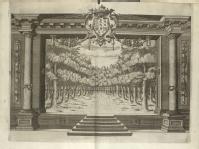
Illustration 26
Illustration 27 shows a moderately tranquil vision of hell conjured up for an opera at Parma in 1628 to celebrate the marriage of Odoardo Farnese.
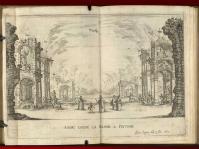
Illustration 27
Multiple examples of elaborate scenes of illusion can be found in these books. Their ambitious character is well conveyed in illustrations of a staged tournament at Ferrara in 1631.
Illustration 28 shows a representative scene
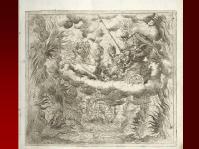
Illustration 28
Mars and Discord descend towards a stage where cloud and flames surround them; they intend to sow the seeds of the war that will initiate the action.
A second scene(Illustration 29) shows three knights in extraordinary garb entering with their pages to defend the cause of peace
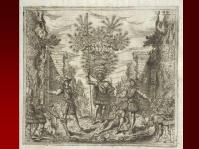
Illustration 29
These are, perhaps, the most extravagant head-dresses ever worn by beings intending to fight. One wonders how the central figure managed to move at all! Clearly, for this Festival, there was scarcely room on stage for other performers, yet the theatre could often be cluttered up with princes who wanted to be close to the action, as in the climax to the opera in Vienna in 1652 celebrating the birth of the Spanish infanta.
This engraving of the scene (Illustration 30) shows the Emperor and his son Leopold King of Hungary installed on the stage, in fair proximity to the fighting about to break out.
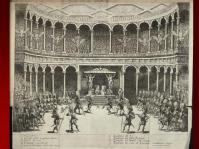
Illustration 30
It is worth noting, in passing, the enormous audience closely packed – as it were – into the stalls and balcony.
